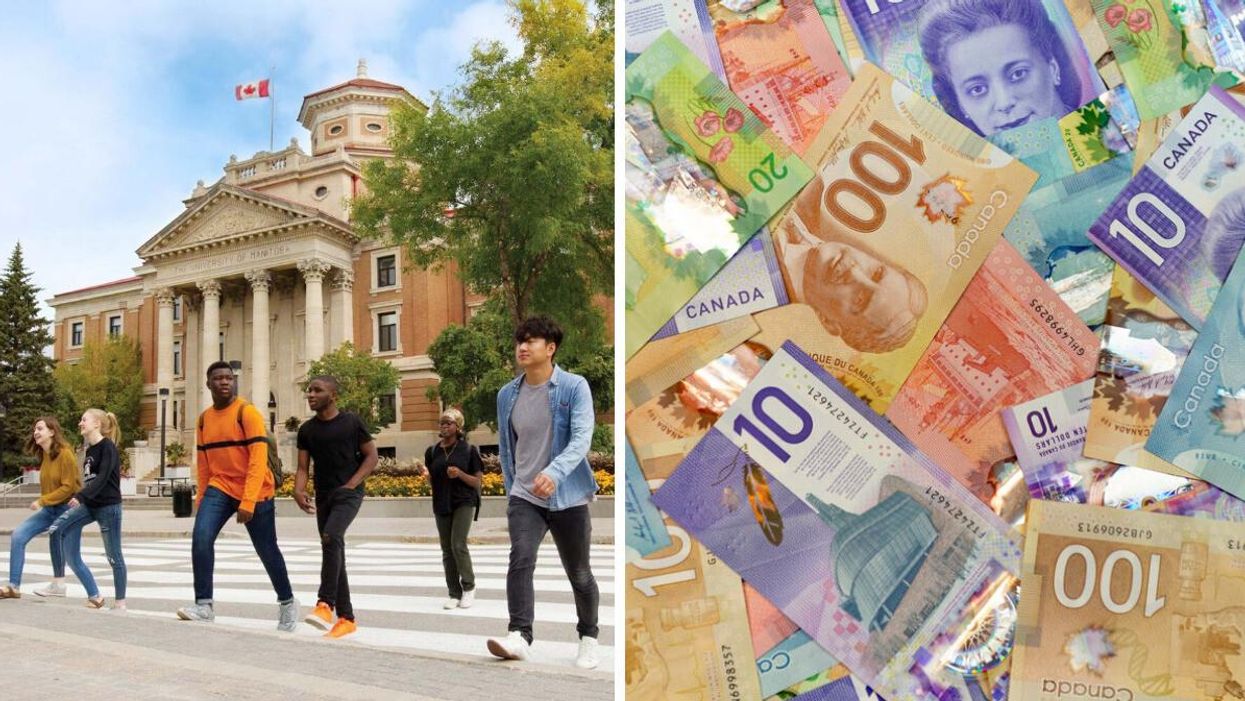Students In Canada Can Get Federal Benefits In 2023 & Here's How Much Money Is Available
The feds have financial support to help pay for school, help with rent and more.

Students on the University of Manitoba campus. Right: Canadian money.
There are federal benefits that post-secondary students in Canada can get in 2023 and quite a lot of money is available.
If you're a student and in need of financial support to help pay for school, help with rent and more, you can take advantage of benefits, grants and incentives that the government of Canada is offering.
Some of the benefits, grants and incentive payments are $100, $500, $2,000 and even $6,000!
Here's what you need to know about how to get money from the government if you're a post-secondary student in Canada.
Loan repayment tax credit
If you're repaying government student loans, you get a 15% tax credit on the interest you pay for your loans every year. The credit applies to interest payments on federal and provincial or territorial student loans.
You can get your T4A documents and statements in your National Student Loan Service Centre account at the start of the calendar year.
Climate action incentive payment (CAIP)
The Climate action incentive payment (CAIP) is a tax-free amount paid to help individuals and families offset the cost of federal pollution pricing.
To be eligible for the CAIP, you must be a resident of Alberta, Saskatchewan, Manitoba or Ontario on the first day of the payment month and the last day of the previous month. You also have to meet at least one of the following conditions:
- be 19 years of age or older
- have (or previously had) a spouse or common-law partner
- are (or previously were) a parent and live (or previously lived) with your child
If you qualify for the incentive, you can expect to receive money on April 15, July 15, and October 15, in 2023.
Depending on where you live, payments could range from just under $100 to more than $500!
Doubled student grants
The federal government is doubling the money you can get Canada Student Grants until July 2023.
With the increase, full-time students can get up to $6,000 in non-repayable aid and students with disabilities can get up to $10,000.
Canada Learning Bond (CLB)
The Canada Learning Bond (CLB) is money that the federal government adds to a Registered Education Savings Plan (RESP).
This is to help pay the costs of full-time or part-time studies after high school at apprenticeship programs, CEGEPs, trade schools, colleges or universities.
With the CLB, the government contributes up to $2,000 to an RESP for an eligible child. This includes:
- $500 for the first year of eligibility
- $100 each year the child continues to be eligible (up to and including the benefit year in which they turn 15)
Also, eligible people who didn't get the CLB as kids can apply for it when they turn 18 years old and until the day before they turn 21 as long as they were born in 2004 or later.
Canada Housing Benefit (CHB) top up
The federal government is offering renters a one-time top-up to the Canada Housing Benefit to help with the cost of renting.
You could get this tax-free one-time payment of $500 if you're eligible based on your income and the amount that you pay in rent.
Applications for the CHB top-up are open until Friday, March 31, 2023.
This article's cover image was used for illustrative purposes only.
- These Federal Benefits Will Help You Pay For Big Purchases, From A Car To A House ›
- The Feds Have Announced A New 'Top Up' Of $500 For The Canada Housing Benefit To Help Renters ›
- Residents Of 4 Provinces Will Receive A Payment From The Feds Today & Here's Who's Eligible ›
- Students In Canada Can Get Up To $2K From A Federal Benefit To Pay For Post-Secondary Education - Narcity ›
- These Undergraduate Programs In Canada Have The Cheapest Tuition & So Many Are Under $6,000 - Narcity ›
- The Government Of Canada Is Hiring Students Across The Country & The Pay Is Up To $34 An Hour - Narcity ›
- The Federal Government Is Planning To Make Changes To Student Grants & You Could Get Over $4,000 - Narcity ›
